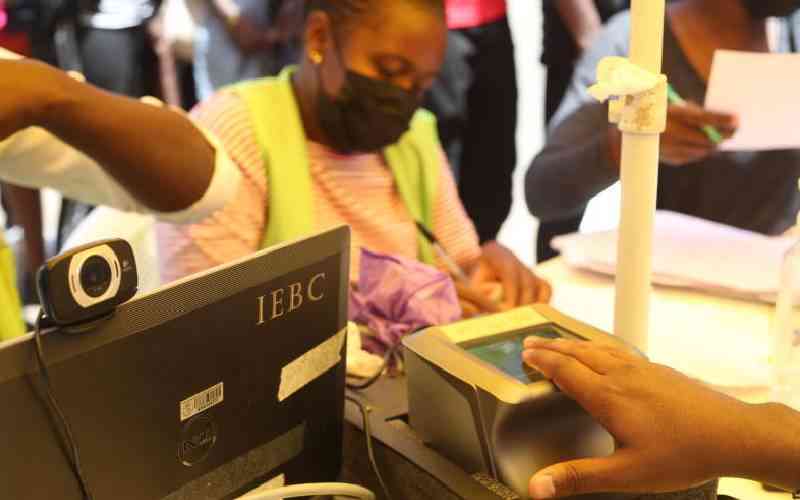The Elections Observation Group (ELOG) has raised concern over the low number of Kenyans who turned up to be registered as voters during the first week of the Continuous Voter Registration (CVR) exercise.
On Friday, October 3, the Independent Electoral and Boundaries Commission (IEBC) reported that it had registered 7,048 new voters, while 259 previously registered voters applied for transfer of electoral areas, and 8 people updated their details.
According to ELOG, should the trend continue, only a few Kenyans will be added to the 22 million others in the current register, far from the 6 million new voters target for the ongoing registration drive.
“While these figures mark a positive start, they represent only 0.11% of the national target of 6.3 million new voters. If evenly distributed across the four weeks, this pace would represent less than 1% of the required weekly average, highlighting the need for intensified civic mobilization and logistical support,” said Victor Nyongesa, ELOG Chairperson.
Follow The Standard
channel
on WhatsApp
The group has blamed the outcome on a lack of targeted interventions and awareness across the 278 constituencies where the exercise is being held. Areas with pending by-elections have been exempted from the drive in line with the constitution.
While urban counties recorded higher registration figures, those in rural areas performed poorly.
Lamu had only added 1 new voter as of October 2, Samburu (18), Tana River (21), and Nyamira (10), in stark contrast to Nairobi’s leading 1,597.
Further, ELOG wants IEBC to clarify the introduction of iris as a biometric identifier owing to the initial opposition it faced from Kenyans.
While responding to the controversy, IEBC chairperson Erastus Ethekon defended the move, saying it is backed by law.
“The iris provides an alternative means of voter identification should fingerprint recognition fail,” he stated.
“The inclusion of iris recognition is expressly permissible under the law, which provides for biometric identifiers such as fingerprints, hand geometry, earlobe geometry, retina and iris patterns, voice waves, DNA, and signatures,” he added.
At the same time, the election observation group has pressed IEBC to explain whether one can be registered in an area and still be eligible to vote in another.
ELOG has recommended enhanced civic education, mobilization, youth engagement, and support for the exempted by-election areas as the registration enters the next phase.
Follow The Standard
channel
on WhatsApp
The Elections Observation Group (ELOG) has raised concern over the low number of Kenyans who turned up to be registered as voters during the first week of the Continuous Voter Registration (CVR) exercise.
On Friday, October 3, the Independent Electoral and Boundaries Commission (IEBC) reported that it had registered 7,048 new voters, while 259 previously registered voters applied for transfer of electoral areas, and 8 people updated their details.
According to ELOG, should the trend continue, only a few Kenyans will be added to the 22 million others in the current register, far from the 6 million new voters target for the ongoing registration drive.
“While these figures mark a positive start, they represent only 0.11% of the national target of 6.3 million new voters. If evenly distributed across the four weeks, this pace would represent less than 1% of the required weekly average, highlighting the need for intensified civic mobilization and logistical support,” said Victor Nyongesa, ELOG Chairperson.
Follow The Standard
channel
on WhatsApp
The group has blamed the outcome on a lack of targeted interventions and awareness across the 278 constituencies where the exercise is being held. Areas with pending by-elections have been exempted from the drive in line with the constitution.
While urban counties recorded higher registration figures, those in rural areas performed poorly.
Lamu had only added 1 new voter as of October 2, Samburu (18), Tana River (21), and Nyamira (10), in stark contrast to Nairobi’s leading 1,597.
Further, ELOG wants IEBC to clarify the introduction of iris as a biometric identifier owing to the initial opposition it faced from Kenyans.
While responding to the controversy, IEBC chairperson Erastus Ethekon defended the move, saying it is backed by law.
“The iris provides an alternative means of voter identification should fingerprint recognition fail,” he stated.
“The inclusion of iris recognition is expressly permissible under the law, which provides for biometric identifiers such as fingerprints, hand geometry, earlobe geometry, retina and iris patterns, voice waves, DNA, and signatures,” he added.
At the same time, the election observation group has pressed IEBC to explain whether one can be registered in an area and still be eligible to vote in another.
ELOG has recommended enhanced civic education, mobilization, youth engagement, and support for the exempted by-election areas as the registration enters the next phase.
Follow The Standard
channel
on WhatsApp
By Denis Omondi
